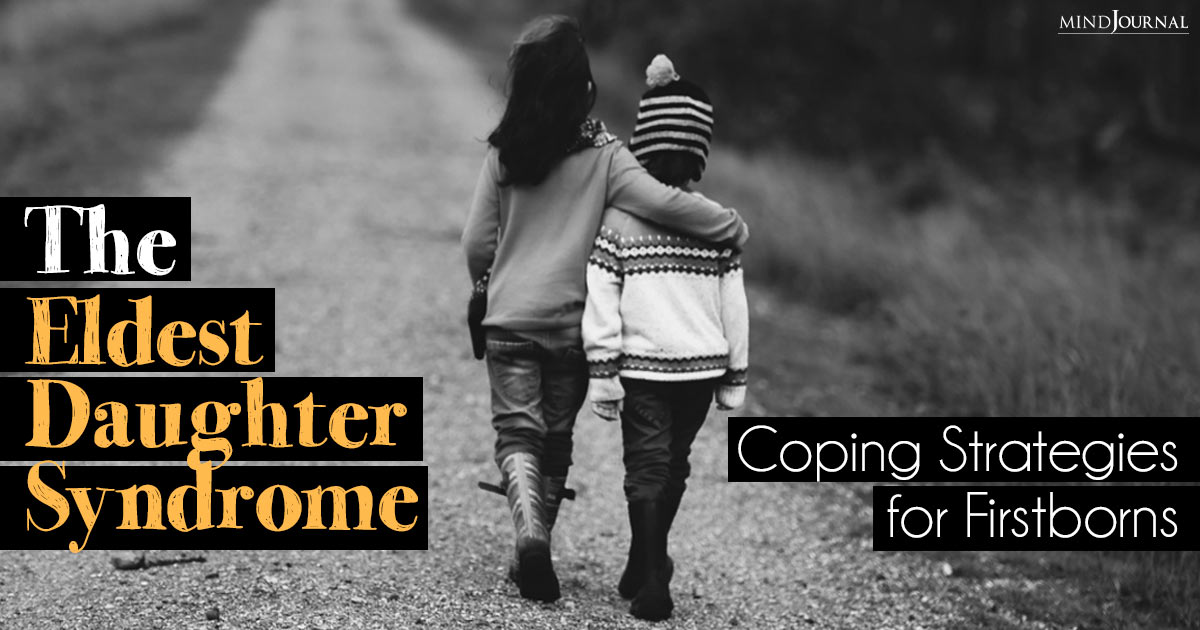Have you ever wondered about the unique challenges faced by the eldest daughters in families? The phenomenon is known as “Eldest Daughter Syndrome”. But wait, what is Eldest Daughter Syndrome?
From shouldering responsibilities to striving for perfection, eldest daughters often find themselves caught in a web of high expectations and emotional demands. So let’s delve into the depths of Eldest Daughter Syndrome, exploring its symptoms, causes, and most importantly, how to heal from Eldest Daughter Syndrome
What is Eldest Daughter Syndrome?

Eldest Daughter Syndrome refers to a set of characteristics and behaviors commonly observed in the first-born daughters within families. It is a phenomenon where the eldest daughter tends to shoulder an excessive amount of responsibility and faces unique challenges due to her position in the family hierarchy.
As these remarkable individuals tend to exhibit a strong sense of responsibility, they tend to be mature beyond their years, and have a desire to please others.
Related: What Is Eldest Daughter Syndrome: 10 Key Signs and Lasting Impacts Of Being The First Child
While these qualities can be seen as positive, they often come at a cost, such as seeking perfectionism and neglecting personal needs, leading to emotional and psychological struggles. Understanding and supporting those affected can aid in their healing and recovery.
Understanding Eldest Daughter Syndrome
To better understand “what is Eldest Daughter Syndrome?”, let us consider the following example.
Sarah, the eldest daughter in a family of three children, feels a strong sense of responsibility from a young age. She becomes a caretaker, helping with chores, looking after her siblings, and maintaining family harmony.
Sarah’s parents unintentionally rely on her more, expecting her to be mature and responsible. She sacrifices her own needs, cooking and helping with homework, striving for academic excellence. Over time, she struggles to say no, seeks validation, and suppresses her own dreams.
This example illustrates how Eldest Daughter Syndrome can manifest in real-life situations. The eldest daughter often carries a significant burden, feeling the need to fulfill societal expectations and meet the emotional needs of her family members.

It is important to note that Eldest Daughter Syndrome is not a clinical diagnosis but rather a concept that highlights the challenges faced by first-born daughters. Understanding this syndrome can help us empathize with individuals who experience it and support them in their journey towards healing and self-discovery.
Eldest Daughter Syndrome Symptoms
Recognizing the Eldest Daughter Syndrome symptoms is crucial for understanding and addressing its impact. Here are some common signs to look out for:
1. Over Responsibility
Eldest daughters often feel the need to take charge and assume responsibilities that may not be age-appropriate. They may become the family mediator, caretaker, or problem-solver, even at the expense of their own well-being.
2. Perfectionism
Striving for perfection becomes a way of life for many eldest daughters. They set impossibly high standards for themselves, always seeking validation and fearing failure.
Related: 50 Rules For Daughters
3. People-pleasing
Eldest daughters often find it challenging to say no and prioritize their own needs. They may go to great lengths to keep others happy, often neglecting their own desires and aspirations.
4. Self-neglect
Due to their focus on taking care of others, eldest daughters may neglect their own self-care and personal growth. Their own dreams and ambitions may take a backseat, leading to a sense of unfulfillment.

Causes of Eldest Daughter Syndrome
Understanding the underlying causes of Eldest Daughter Syndrome can enable us to gain clarity on “what is Eldest Daughter Syndrome?”.
Here are a few factors that contribute to its manifestation:
1. Family Expectations
Society often places certain expectations on the eldest child, perpetuating the belief that they should be responsible, role models, and caretakers within the family unit.
2. Parental Pressure
Parents may unknowingly place higher expectations on their eldest daughters, relying on them to set an example for younger siblings. This can lead to an overwhelming sense of responsibility and a fear of disappointing loved ones.
3. Birth Order Dynamics
Being the first-born often means navigating uncharted territory within the family. Eldest daughters may face increased pressure to succeed, as their achievements are seen as a reflection of their parents’ parenting skills.
Related: The Good Daughter Syndrome: 7 Signs of Narcissistic-Mother Empath Daughter Dynamics

How to Heal from Eldest Daughter Syndrome
While the challenges posed by Eldest Daughter Syndrome are real, it is essential to remember that healing and growth are possible. Here are some strategies that can help you learn how to heal from Eldest Daughter Syndrome:
1. Self-Reflection and Awareness
Start by recognizing and acknowledging the impact of Eldest Daughter Syndrome on your life. Cultivate self-awareness and reflect on the patterns and behaviors that have been influenced by this syndrome.
2. Setting Boundaries
Learn to set healthy boundaries by understanding your own needs and limits. Practice saying no when necessary and prioritize self-care without guilt.
3. Embracing Imperfection
Challenge the notion of perfectionism and embrace the beauty of being imperfect. Allow yourself to make mistakes, learn from them, and grow as an individual.
4. Seeking Support
Reach out to trusted friends, family members, or professionals who can provide a safe space for you to express your emotions and seek guidance. Therapy or counseling can be a particularly beneficial strategy on how to heal from Eldest Daughter Syndrome.
5. Rediscovering Your Identity
Take time to explore your own passions, interests, and goals. Reconnect with what brings you joy and fulfillment, independent of the expectations placed upon you.

Takeaway
So what is Eldest Daughter Syndrome? Eldest Daughter Syndrome is a real and often overlooked phenomenon that impacts the lives of many remarkable individuals. By understanding its symptoms, causes, and the steps to heal from its effects, we can embark on a journey of self-discovery and growth.
Remember, you are more than just an eldest daughter – you are a unique individual with dreams, aspirations, and the capacity to create your own path. Embrace your journey, celebrate your successes, and nurture your soul with self-compassion.
Related: What Are Daddy Issues? How Fathers Impact A Daughter’s Romantic Relationships
Frequently Asked Questions (FAQs):
What is the psychology of the eldest daughter?
The psychology of the eldest daughter often involves responsibility, leadership, and caretaking roles within the family dynamic.
What are the struggles of being the eldest daughter?
Struggles of being the eldest daughter may include high expectations, pressure to set an example, and feeling overlooked.
What is the eldest daughter complex?
The eldest daughter complex refers to the psychological impact of being the oldest sibling, often involving perfectionism and overachievement.










Leave a Reply